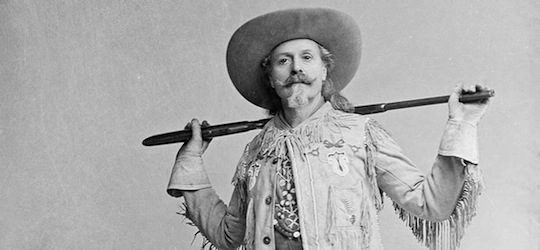William F. “Buffalo Bill” Cody’s (1845-1917) life and career span the transition from the frontier to the post-frontier eras in the history of the North American West, and his legacy contributes to both the popular imagery of the mythic West and to the social and economic foundation of the modern western section of the United States. From the late nineteenth-century Dime Novels and “Buffalo Bill’s Wild West” exhibition that made him an international celebrity, to his early twentieth-century speculative investments in mining and irrigation projects and his role as a booster for the Wyoming town that bears his name, Cody’s life is a lens through which we may profitably re-examine the complex, multifaceted story of the American West.
The following interpretive works of digital scholarship related to William F. “Buffalo Bill” Cody are published by Cody Studies, edited by Douglas Seefeldt, Senior Digital Editor, The Papers of William F. Cody.
- Robert E. Bonner and Rebecca Wingo, The Artistic Legacy of Buffalo Bill Cody, The Papers of William F. Cody, 2016.
William F. “Buffalo Bill” Cody began to bring art into his life in the later 1890s when he was engaged to some degree with more than a dozen painters. Some, like Charles S. “Mountain Charlie” Stobie and Henry H. Cross, were old friends from a previous life on the prairie. Some were young and unknown, like Robert Farrington Elwell, or slightly older and possessed already of some professional recognition, like Irving R. Bacon or A. D. M. Cooper. Two of them, Frederic Remington and Charles Schreyvogel, contended for supremacy among western painters in the first decade of the twentieth century. Others came and went, showing up at Wild West performances or visiting Cody in Wyoming or elsewhere, but these tangential relationships do not define Buffalo Bill’s artistic legacy. Cody wanted a variety of things from his painters. In the first place, he hoped to establish some kind of record of his life in Wyoming. His move into the Big Horn Basin, where he set out in 1895 to build an irrigation colony, a set of ranches, and a town to carry his name, led him to see a place where art and artists could fit into his life. On the face of it, William Cody’s efforts to patronize and sponsor painters produced results that included both failure and success. He got a number of paintings out of it, but few of them are of any distinction. His naïve confidence in his own judgment of artistic talent, together with his diminishing financial resources in the last decade of his life, made the project difficult.
- Michelle Delaney and Rebecca Wingo, ‘I Shall Be Glad To See Them’: Gertrude Käsebier’s ‘Show Indian’ Photographs, The Papers of William F. Cody, 2012.
Gertrude Käsebier, a notable pictorialist photographer, helped shape the field of photography as a fine art around the turn of the twentieth century. Widely published, her work received acclaim from art notables such as Alfred Stieglitz and Auguste Rodin. Her lesser known works are of Lakota (Sioux) “Show Indians” from Buffalo Bill’s Wild West when they came through New York City in April 1898. Käsebier’s photographs of the “Show Indians” led to the creation of what is arguably the most respected set of images produced during her career. The portraits were selectively, and infrequently, exhibited and reproduced in contemporary journals. While Käsebier received some of the highest prices in the nation for photographic work, she often gave away the Sioux portraits to those individuals expressing a genuine interest in and appreciation for Native American culture. Käsebier’s collection of Native American portraits is a poignant testimony to her independent spirit and her modern awareness of the possibilities of fine art photography.
